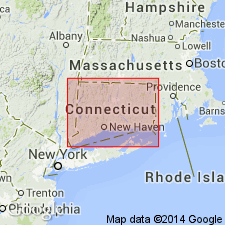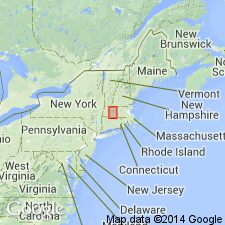
- Usage in publication:
-
- Erving Formation*
- Modifications:
-
- Overview
- AAPG geologic province:
-
- New England province
Summary:
Erving Formation mapped in Bronson Hill anticlinorium as undivided and as three informal subdivisions where possible to map separately: 1) mixed mica schist and amphibolite, 2) granofels and schist, and 3) amphibolite. Age is Early Devonian.
Source: GNU records (USGS DDS-6; Reston GNULEX).

- Usage in publication:
-
- Erving Formation*
- Modifications:
-
- Areal extent
- AAPG geologic province:
-
- New England province
Summary:
Extended to Connecticut in Bronson Hill anticlinorium. Age generalized to Devonian.
Source: GNU records (USGS DDS-6; Reston GNULEX).

- Usage in publication:
-
- Erving Formation*
- Modifications:
-
- Overview
- AAPG geologic province:
-
- New England province
Summary:
Erving Formation in its type area consists of gray, well-bedded fine-grained, quartz-plagioclase-biotite granulite with very thin to thick beds of muscovite-biotite schist. Second most abundant rock type is hornblende-andesine-epidote-sphene amphibolite; occurs west of Pelham dome, as well as in areas around Quabbin Hill, Wilbraham, Whately, and Leeds. Pink coticule granulite occurs within main granulite bodies, usually within 1 to 2 m of contact with amphibolite; common in type area, as well as near Leverett and near Quabbin Hill on shores of Quabbin Reservoir. Near base of formation in Wilbraham area, includes a unit of interlayered amphibolite and gray to rusty schist. In most areas, Erving is highest exposed unit, except in Wilbraham and Whately areas where it is overlain by Waits River and Gile Mountain Formations, respectively. Thicknesses vary from 200 to 900 m. Age is Devonian in this report. [Papers presented as chapters in U.S. Geological Survey Professional Paper 1366 are intended as explanations and (or) revisions to MA State bedrock geologic map of Zen and others (1983) at scale of 1:250,000.]
Source: GNU records (USGS DDS-6; Reston GNULEX).
For more information, please contact Nancy Stamm, Geologic Names Committee Secretary.
Asterisk (*) indicates published by U.S. Geological Survey authors.
"No current usage" (†) implies that a name has been abandoned or has fallen into disuse. Former usage and, if known, replacement name given in parentheses ( ).
Slash (/) indicates name conflicts with nomenclatural guidelines (CSN, 1933; ACSN, 1961, 1970; NACSN, 1983, 2005, 2021). May be explained within brackets ([ ]).

